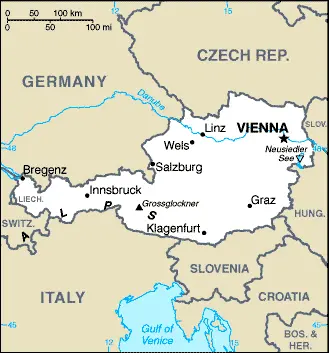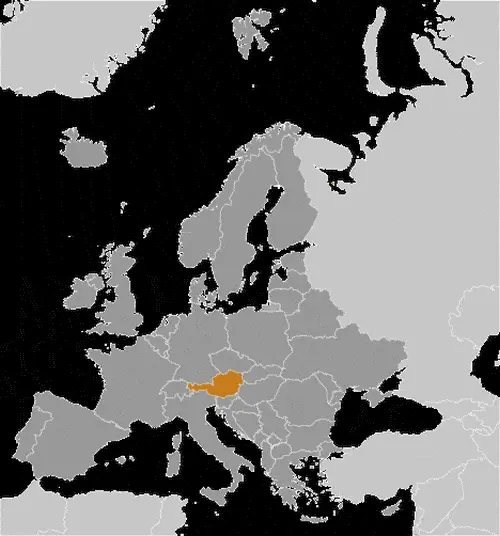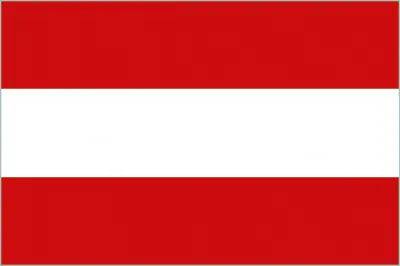Google Maps and Detailed Facts of Austria (AT). This page lets you explore Austria and its border countries (Country Location: Central Europe, north of Italy and Slovenia) through detailed Satellite imagery – fast and easy as never before Google Maps.
Find comprehensive information about this country’s diversity below: Google maps, geography, economy, science, people, culture, environment, government, and history – All in One Wiki page.
There is also a Street View and free Driving Directions at your service. Your Google Satellite Map Sightseeing in Austria, Europe, starts here at Driving Directions and Maps.com.
About Austria in detail
Table of contents
- Background
- Overview
- Google Maps
- Climate
- Geography
- Resources and Land Use
- Population Data
- Economic Data
- Drinking Water Source
- Population, Median Age, Migration, and Citizenship
- Average Number of Childbirths
- Is this country a Safe Destination?
- Healthcare and Infectious Diseases
- Natural Hazards
- The Flag and Other Symbols
- Constitution
- Legal System
- About the Unemployment Rate, Labor Force, and Poverty Line
- About the Budget and Central Government Debt
- Inflation Rate and Prime Lending Rate
- Export/Import Partners and Data
- Renewable Energies Used
- Telecommunication Data, Calling Code
- Transport Infrastructure
- More Interesting Facts
Background
Austria, a landlocked country in Central Europe, is renowned for its rich history, cultural heritage, and stunning landscapes. The Republic of Austria, established post-World War I, has a democratic and federal structure. Known for its pivotal role in European history, especially during the era of the Austro-Hungarian Empire, Austria today is a blend of historical magnificence and modern innovation.
Overview
Austria’s strategic location in the heart of Europe makes it a key player in the European Union. Its well-preserved natural beauty and urban architectural wonders attract millions of tourists yearly. Austria’s economy is robust, with significant contributions in tourism, manufacturing, and technology. The nation’s commitment to environmental sustainability is also evident in its policies and lifestyle.
Official Name: Republic of Austria
Date of Formation: 1955
Capital: Vienna
Population: 8,940,860 (2023 est.)
Total Area: 32,386 Sq. Miles / 83,871 Sq. Km
Population Density: N/A
Languages: German (official nationwide) 88.6%, Turkish 2.3%, Serbian 2.2%, Croatian (official in Burgenland) 1.6%, other 5.3%
Religions: Roman Catholic 55.2%, Muslim 8.3%, Orthodox 4.9%, Evangelical Christian 3.8%, Jewish 0.1%, other 5.4%, none 22.4% (2021 est.)
Ethnic Origin: Austrian 80.8%, German 2.6%, Bosnian and Herzegovinian 1.9%, Turkish 1.8%, Serbian 1.6%, Romanian 1.3%, other 10% (2018 est.)
Government: Federal parliamentary republic
Currency: Euro (EUR)
Literacy Rate: N/A
Calorie Consumption: N/A
Austria Google Maps
Google Maps provides an invaluable tool for exploring Austria’s diverse geography, from the majestic Alps to its serene lakes and rivers. With detailed mapping, it’s easy to navigate Austria’s cities, like Vienna and Salzburg, or plan trips to its scenic countryside. Whether for practical navigation or virtual tourism, Google Maps is an essential companion for anyone interested in Austria.
Bordering eight countries in the heart of Europe, Austria was created in 1918 after the collapse of the Habsburg Empire. Neutral after World War II, it joined the EU in 1995. Mainly mountainous. Alps and foothills cover the west and south. Lowlands in the east are part of the Danube River basin.
The map below shows Austria’s cities, towns, highways, main roads, streets, and Street Views. To find a location, use the form below, type any city or place, view a simple map, and click the “show map” button.
The Google Map above shows Austria with its location: Europe (geographic coordinates: 47 20 N, 13 20 E) and the international borders of Austria; total: 2,524 km. Border countries (total: 8): the Czech Republic 402 km, Germany 801 km, Hungary 321 km, Italy 404 km, Liechtenstein 34 km, Slovakia 105 km, Slovenia 299 km, Switzerland 158 km; furthermore, it’s inland counties boundaries.
The map of Austria and Europe is for informational use only. No representation is made or warrantied given any map or content by the Driving Directions and Maps site. The user assumes all risks of using this Austria Google map and facts/wiki.
Climate
Austria’s climate is as varied as its topography, with distinct climatic conditions influenced by its geographical features:
- Alpine Climate in the West and Central Regions: A large part of Austria is dominated by the Alps, where an Alpine climate prevails. This region experiences significant snowfall in the winter, making it a popular destination for winter sports enthusiasts. Ski resorts in areas like Tyrol and Vorarlberg are world-renowned. Winter temperatures in these regions can drop below freezing, while summers are relatively mild, with average temperatures around 20°C (68°F). This climate supports a range of Alpine flora and fauna and contributes to the stunning landscapes Austria is famous for.
- Continental Climate in the Eastern Plains: The eastern part of Austria, including regions like Vienna and Burgenland, is characterized by a more continental climate. This area sees hotter summers and colder winters compared to the Alpine regions. Summer temperatures can exceed 30°C (86°F), and winter temperatures can fall well below freezing. The continental climate is conducive to agriculture, including cultivating grains, fruits, and Austria’s famous vineyards.
- Rainfall Distribution: Austria generally experiences fairly evenly distributed rainfall throughout the year. However, the western parts of the country, especially closer to the Alps, receive more precipitation than the eastern plains. The average annual rainfall in Austria is about 1,100 mm (43 inches), with the highest rainfall typically occurring in June and July.
- Microclimates: Austria also has microclimates due to varying elevations and topographical features. For instance, the areas around Lake Constance in the west experience milder temperatures, while the Danube Valley can have higher summer temperatures and foggy conditions in winter.
- Impact on Landscapes and Biodiversity: The diverse climatic conditions across Austria significantly influence its natural landscapes. The Alpine regions are home to lush forests, mountain meadows, and glacial features, while rolling hills, fertile fields, and vineyards characterize the eastern plains. This diversity in climate and landscapes supports a rich biodiversity.
- Climate Change Impacts: Austria, like many other countries, faces the impacts of climate change. This includes rising temperatures, changing precipitation patterns, and potential impacts on ecosystems, particularly in the Alpine regions where glaciers retreat.
In summary, Austria’s climatic diversity, ranging from Alpine conditions in its mountainous regions to more continental influences in the plains, significantly shapes its natural environments, economic activities, and cultural life. This variety in weather patterns contributes to the country’s scenic beauty and makes Austria a destination with year-round appeal.
Geography
Austria’s geography, marked by its Alpine terrain and significant river systems, presents a picturesque and varied landscape:
- Mountainous Terrain: The Alps dominate much of Austria’s terrain, covering about 60% of the country’s land area. This mountain range significantly influences Austria’s climate, biodiversity, and economic activities, particularly tourism. The Austrian Alps are known for their stunning scenery and are a major destination for skiing, hiking, and mountaineering.
- Size and Land Area: Austria covers an area of 83,879 square kilometers (about 32,386 square miles), making it a medium-sized European country. Despite its relatively small size, the country’s diverse landscapes range from mountainous regions to rolling plains.
- Danube River: The Danube, Europe’s second-longest river, flows about 350 kilometers (217 miles) through Austria. It enters the country near Passau and exits into Slovakia at Bratislava. The river is not just a key waterway but also plays an important role in Austria’s economy and is central to many cultural and historical sites along its banks.
- Highest Point: at 3,798 meters (12,461 feet), Grossglockner is Austria’s highest peak and a prominent feature of the Hohe Tauern range in the Central Eastern Alps. It is a significant tourist attraction, famous for its panoramic views and the Grossglockner High Alpine Road, which offers one of the most scenic drives in Europe.
- Surrounding Countries: Austria is a landlocked country bordered by eight countries:
- Germany and the Czech Republic to the north,
- Slovakia and Hungary to the east,
- Slovenia and Italy to the south, and
- Switzerland and Liechtenstein to the west. These borders have influenced Austria’s cultural and historical development.
- Other Geographical Features: Besides the Alps and the Danube, Austria features numerous lakes, such as Lake Constance in the west and Lake Neusiedl, the largest endorheic lake in Central Europe, on the Hungarian border. The country also has several national parks, like the Gesäuse National Park, which protect its diverse ecosystems.
- Forest Coverage: About 47% of Austria’s land area is covered by forests, contributing to its lush landscapes and playing a vital role in its ecology.
- Agricultural Land: The eastern and northern parts of Austria, where the terrain is flatter, are more suitable for agriculture and are where most of the country’s farming activities occur.
Austria’s geography, characterized by its Alpine mountains, significant river systems, and diverse landscapes, contributes to its scenic beauty and plays a crucial role in its climate, biodiversity, and economic activities. The country’s central location in Europe, surrounded by various nations, further adds to its cultural richness and historical significance.
Resources and Land Use
Austria is rich in natural resources, including timber, magnesite, and iron ore. The country’s land use primarily involves agriculture (which covers about 38.4% of the land), forestry, and pastures. Austria’s commitment to renewable resources is evident in its extensive forest cover and progressive environmental policies.
Population Data
As of the latest data, Austria has a population of approximately 8.9 million. The population density is around 107 people per square kilometer (about 277 people per square mile), with a significant portion residing in urban areas, particularly in Vienna.
Economic Data
Austria’s GDP stands robustly at around 446 billion USD, with a per capita GDP of approximately 49,000 USD. A high standard of living, a well-developed social market economy, and a strong industrial base characterize its economy. Austria is also a member of the Eurozone, using the Euro as its currency.
Drinking Water Source
Austria is fortunate to have abundant freshwater resources. Its drinking water is primarily sourced from ground and spring water, known for its high quality. The country also invests heavily in water management and purification systems, ensuring safe and accessible drinking water for its population.
Population, Median Age, Migration, and Citizenship
Austria’s median age is approximately 44.2 years, reflecting a relatively mature population. Migration plays a significant role in Austria’s demographic composition, with a notable number of immigrants, primarily from Eastern Europe, Germany, and Turkey. Austrian citizenship laws are based on jus sanguinis principles, with naturalization opportunities under specific conditions.
Average Number of Childbirths
The fertility rate in Austria is about 1.46 children per woman, indicative of the broader European trend of lower birth rates. The government has implemented various family-friendly policies to support parents and encourage a balance between work and family life.
Is this country a Safe Destination?
Austria is considered one of the safest countries in the world. Its low crime rate, effective law enforcement, and overall stability make it a popular destination for tourists and expatriates. However, like any country, it is advisable to take standard safety precautions, especially in urban and tourist areas.
Healthcare and Infectious Diseases
Austria boasts a high-quality healthcare system accessible to all citizens and residents through its public health insurance scheme. Infectious diseases are well-controlled with high standards of hygiene, advanced medical facilities, and effective public health policies.
Natural Hazards
Austria’s main natural hazards are related to its mountainous terrain, including avalanches in the Alpine regions during winter. The country is also prone to flooding, particularly along the Danube River. However, Austria has implemented extensive measures to mitigate these risks, including advanced warning systems and infrastructure development.
The Flag and Other Symbols
The Austrian flag, one of the oldest national flags in the world, consists of three equal horizontal bands of red (top), white, and red. The coat of arms, a black eagle on a yellow background, symbolizes Austria’s imperial history. These symbols reflect Austria’s national identity and historical heritage.
Constitution
Austria’s constitution, enacted in 1920 and reinstated in 1945, is the legal foundation of the Republic. It establishes the principles of democracy, the rule of law, and federalism. Amendments over the years have adapted the Constitution to changing times while maintaining its core principles.
Legal System
Austria operates under a civil law system influenced by Roman law. Its legal framework is characterized by a strong emphasis on protecting individual rights and freedoms. The judiciary is independent, ensuring the rule of law and fair administration of justice.
About the Unemployment Rate, Labor Force, and Poverty Line
Austria’s unemployment rate is around 5.5%, showcasing its strong labor market. The skilled and diversified labor force contributes to the country’s economic stability. Poverty is relatively low, with social welfare systems supporting those in need.
About the Budget and Central Government Debt
Austria’s budget reflects its commitment to economic stability and social welfare. The central government debt is managed prudently, with measures in place to ensure fiscal responsibility and sustainability. This approach has helped Austria maintain a stable economic environment.
Inflation Rate and Prime Lending Rate
The inflation rate in Austria is controlled, reflecting the overall stability of the Eurozone. The prime lending rate is set in accordance with the European Central Bank’s policies, facilitating economic growth and stability.
Export/Import Partners and Data
Austria’s main export partners include Germany, the United States, and Italy, while its primary import sources are Germany, China, and Italy. The country’s export-import activities, focusing on machinery, vehicles, pharmaceuticals, and electrical equipment, are vital to its economy.
Renewable Energies Used
Austria is a leader in renewable energy, with a significant portion of its electricity generated from hydropower, wind, and solar energy. The country’s commitment to reducing carbon emissions and promoting sustainable energy sources is evident in its policies and investments.
Telecommunication Data, Calling Code
Austria’s telecommunication infrastructure is advanced, with widespread access to high-speed internet and mobile services. The country’s international calling code is +43, connecting it seamlessly to the global communication network.
Transport Infrastructure
Austria’s transport infrastructure is highly developed, featuring an extensive network of roads, railways, and public transit systems. The country’s location in Europe makes it a key transit route, with excellent connections to neighboring countries.
More Interesting Facts
Austria is famous for its musical heritage, being the birthplace of legendary composers like Mozart and Strauss. It is also known for its culinary delights, including Wiener Schnitzel and Sachertorte. The tradition of coffee houses, a UNESCO intangible cultural heritage, adds to Austria’s unique charm.
Did You Know?
- Cultural Capital of Classical Music: Vienna, Austria’s capital, is widely regarded as the world’s music capital. It was home to many great composers, including Mozart, Beethoven, Schubert, and Strauss, and continues to be a global center for classical music.
- Oldest Zoo in the World: The Vienna Zoo, established in 1752, is the oldest continuously operating zoo worldwide. It was originally founded as an imperial menagerie by Emperor Francis I.
- Innovative Environmental Policies: Austria is a leader in environmental sustainability and recycling. The country has one of the world’s highest waste recycling rates, making significant efforts to reduce landfill waste and promote renewable energy.
- Lake with Drinking Water Quality: The Wörthersee, one of Austria’s largest and warmest Alpine lakes, is known for its drinking water quality. The lake is a popular summer destination for its clear, clean waters.
- Largest Ice Cave: The Eisriesenwelt in Werfen, near Salzburg, is the world’s largest ice cave. This natural wonder extends over 42 kilometers (26 miles) and attracts thousands of visitors annually.
- Origin of the Croissant: Despite its association with France, the croissant was actually inspired by the Austrian kipferl. Marie Antoinette, an Austrian princess who married King Louis XVI, introduced it to France.
- The Birthplace of Snow Globes: Snow globes were invented in Austria in 1900 by Erwin Perzy, who attempted to improve the brightness of lightbulbs.
- First Psychotherapist: Sigmund Freud, the founder of psychoanalysis, was born in Austria. He spent most of his life in Vienna, where he developed many of his groundbreaking theories.
- World’s Oldest Wheelchair-Accessible Mine: The Salzwelten in Hallstatt is the world’s oldest salt mine and wheelchair-accessible. Mining activity in this area dates back to 8000 years ago.
- Historical Coffee Culture: Coffee culture is integral to Vienna’s lifestyle. The city’s coffee houses, known for their traditional elegance, have been designated a UNESCO Intangible Cultural Heritage.
These interesting facts about Austria reveal a country rich in cultural heritage, natural wonders, and innovations. From being a hub of classical music to pioneering environmental initiatives, Austria presents a blend of historical significance and modern advancement.
Many thanks for visiting and sharing this map & country information site!



